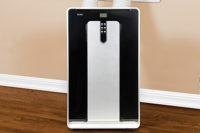Scott Albanese, owner of the firm, remembers his first reaction to the thought of installing a boiler. “It wasn’t that long ago that a boiler exploded and killed a guy in Portage, Indiana. It was in all our papers out here, as well as in the Chicago papers, and it was a big story on the nightly news. So boilers are intimidating.
“We have over 40 people working in our plant. Their safety was our number-one concern. And we had no background knowledge of boilers.”
Albanese’s fears were allayed when he saw the vertical-tube, low-water-content design of Miura boilers (Miura Boiler West, Wheeling, IL). He said, “Miura has so many backups that, if a dangerous condition got past their safeties — they have safety upon safety which shut down the boiler — it would be more like a firecracker instead of a 2,000-pound bomb.”
Where's the water?
Although they are categorized as watertube boilers, Miura models (developed in Japan but built in seven plants around the world) only hold up to 65 gal of water. They are designed to immediately dispatch the steam energy they create out of the boiler.As soon as steam forms, it separates from the water in the tubes and moves up out of the water tubes into an area above the baffle plate. From there it immediately goes into the cyclone separator where any condensation drops into a return pipe. The dry, 99%-plus saturated steam flows from the boiler into the heating pipes and/or process and goes to work.
From a cold start, this procedure takes 5 min.
The confectionery is 32,000 sq ft and uses the boiler to provide heat, steam for processing, and hot water. The 150-bhp boiler runs 12 hrs a day. It is off the other 12 hrs, but is at full steam again (125 psi) in minutes.
Warranty, size are deciding factors
According to Albanese, “When we did hard side-by-side comparisons, one of the things that swayed us between the boilers we chose to compare was the optional Miura 25-year warranty, as opposed to the five-year warranty of the other brand.”The company’s floating header design contributes to its longer warranty. In this design, the headers are not attached to any other part of the boiler. Therefore, the water tubes are unrestricted as they heat and cool.
It’s because the tube ends of conventional boilers are in fixed positions that they are damaged when a boiler is brought up to steam too quickly.
The size of the Miura boiler was the clincher for Albanese. “Its low profile — it took up very little space — sold me.” Typically, these boilers take up 50% less floor space than conventional units, and also save fuel, according to the manufacturer. The compact design means less heat is dissipated from the boiler into the surrounding environment.
Additional energy savings result from the boiler’s fast start-up capability. Most boilers are turned down, but not off, when steam demand drops. The Miura boiler can be switched on and off as needed. And, less energy is required on restart because there is less water to heat.
Multiple boilers save still more
Daubert Industries, Burr Ridge, IL, is a manufacturer of rust preventatives (for undercoating cars), anti-corrosion fluids, lubricants and coolants for the metalworking industry, and adhesives for the wood laminates industry.Recently, the company replaced two, old 300-bhp boilers for its operations with four 200-bhp Miura boilers.
Ron Sobkowiak, Daubert’s chief maintenance engineer, noted that “We have some of our tanks at full line pressure, which is 105 to 115 psi, but others are regulated down to 15 or 30 psi.” Temperatures vary between 275° and 320°F, and have to stay that high whether the tanks are used for 1 hr or in continuous operation, he added.
The firm also uses steam for tracing the lines and steam heat for temperature control on some of the bulk storage tanks for its raw materials.
Under Daubert’s old system, one boiler was sized for the full load or demand of the plant and the second boiler was planned for backup. The backup boiler, in practice, rarely stood by cold — it shared the load of the plant.
In this type of situation, the average, annual load of any standalone boiler sized for peak load operations is 35% (or about 210 bhp for this case). Share that load with a backup boiler and the load drops to about 17.5% per boiler throughout the year. The average efficiency of a boiler operating under these conditions is about 70%.
With four 200-bhp Miura boilers (three for peak load and one for backup) the average load will be two boilers at 52.5% load with the other boilers down. Average annual efficiency with this design will be 83%.
Under control
Sobkowiak was also impressed with the Miura controller. “It’s impressive the way the controller can control up to 15 units in a multiple installation — cycling them on and off as necessary — and can watch the times that they run.“For instance, in our case, we have four boilers but we very rarely need all four, so the controller usually has one shut down and on standby. What it will do is monitor how long each unit runs and change off run times from one unit to another in order to balance the usage on all four units. Our boilers run 24 hours a day, though no boiler operator may be in the plant for up to eight hours of the day.”
Since Daubert’s maintenance control system is computerized, the company is adopting Miura’s online system to maintain the boilers. The maintenance department doesn’t have to watch the equipment; when a boiler is online, as soon as something goes wrong, it automatically calls the maintenance office.





